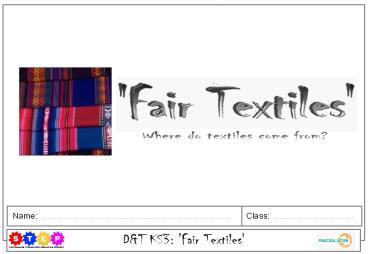Name: PowerPoint PPT Presentation
1 / 17
Title: Name:
1
Name
Class ..
2
How much do we know about where our clothes come
from? Take a look at the labels in the clothes
youre wearing today. Visiting all the countries
mentioned would probably take you on a pretty
impressive world tour! Can you imagine what life
is like for the people who make your T-shirts,
jeans and underwear? The reality is often harsh.
Many of the clothes we buy on the high street are
made in sweatshops, where workers receive low
wages, work in poor conditions and have no
rights. And how about the textiles your clothes
are made from? If you are wearing anything made
from cotton, the raw material is likely to have
been sprayed with chemicals that pollute the
environment and endanger the lives of animals and
farm workers. How can we make things better for
people and the environment through the textile
products we buy and design?
Design and make a product (a bag, puppet or
T-shirt) from textiles that do not harm people or
the environment (sustainable textiles) such as
using materials from organic or ethical sources
or with logos and designs, which highlights
ethical messages.
In this unit you will
- gain knowledge and understanding of the design
and make process - understand who you are designing for by creating
a customer profile - design and label a range of products
- write a design specification
- produce a step-by-step plan for making your
product - make a quality product.
- add 10 keywords to your vocabulary
Cotton, organic, manufacture, production,
properties, care label, assemble, recycling,
biodegradable, prototype.
3
Go to the Learning Context page at
http//www.stepin.org/index.php?idft_learning
and look at the Did you know? facts. Follow the
links and collect your own fascinating facts
about textiles and write them down here.
4
Go to the Research page at ((need specific
address for this part of the site)) and read the
information about organic cotton, sweatshops and
batik-making and the case studies about Kente
cloth and organic cotton in Peru. Using words and
pictures, create a mood board in the cogs below
to illustrate the theme of sustainable textiles
(textiles that dont harm people or the
environment).
5
Choose a sustainable textiles product (for
example, something made from organic cotton or a
fair-traded garment) and answer the following
questions by filling in the boxes.
6
Choose a textiles product that is made from
conventional fabric and was probably made in a
sweatshop. Fill in the boxes below for this
second product.
7
(No Transcript)
8
- I want my new textile product to
- ________________________________________________
_____________________ - ________________________________________________
_____________________ - ________________________________________________
_____________________ - ________________________________________________
_____________________ - ________________________________________________
_____________________ - ________________________________________________
_____________________ - ________________________________________________
_____________________ - ________________________________________________
_____________________ - ________________________________________________
_____________________ - ________________________________________________
_____________________ - ________________________________________________
_____________________
9
Go out and do a survey. Ask some possible
customers what they would like etc. Add their
comments into the speech bubbles below
Who is going to buy and use your product? What do
they like? What dont they like? Write, draw and
stick pictures here to show the type of customer
you are designing for
10
How can you join and combine materials to make
your product? Write, draw and stick examples here
to show the different joining techniques you
could use.
11
Using your research, specification and customer
profile, draw at least FIVE different design
ideas for eco-friendly textile products. Remember
to consider the sustainability of your product.
Label your drawings and explain any changes that
you decide to make to your design. You can start
your ideas on this page and continue on the
following page(s)
Remember to evaluate your work as it develops.
Ask yourself 1. Which is your favourite design
and why? 2. How could you improve it? 3. List at
least three pieces of equipment you would use to
make it. 4. What other features can you comment
on?
Over 45 per cent of all cotton grown in the
United States is genetically engineered.
12
(No Transcript)
13
Look at your specifications and your design ideas
to select the most appropriate design. Draw your
final design here.
14
Draw and write a step-by-step plan for making
your product.
Fill in the chart below to show what equipment
you are going to use to make your product. How do
you plan to use each piece of equipment?
15
How could you have improved your work on this
project? Try to think about the way you worked,
rather than about your final product.
Design work Identify two faults with your design
work and suggest improvements you could make. 1)
Fault Improvement 2) Fault
Improvement
Practical work Identify two faults with your
practical work and suggest improvements you could
make. 1) Fault Improvement 2)
Fault Improvement
Personal evaluation Overall, how do you think you
tackled this project? What were your strengths
and weaknesses? What did you enjoy most? What did
you find easy? What was difficult? Try to be as
detailed as possible.
16
Now it is time to judge the quality of your final
product using your design specification. In the
table below, fill in what you said you wanted
your product to do (your specification) and then
say how well your final product does each of
these things.
My targets for the next project are
Assessment Effort level Designing and making
level
17
Exploring existing ideas
Product specification
Exploring ideas
Developing modelling ideas
Generating design ideas
Final design
Planning
Evaluation

